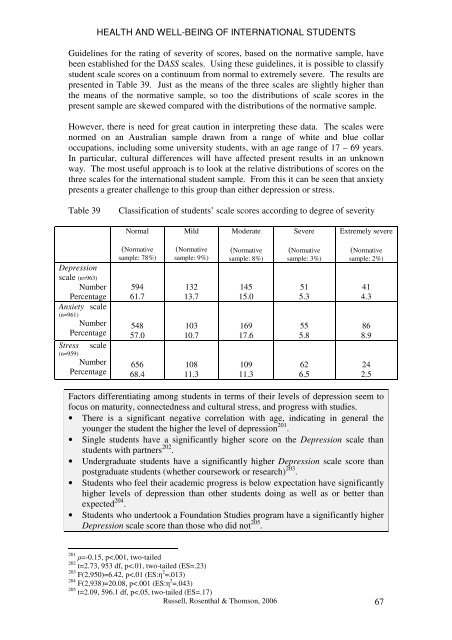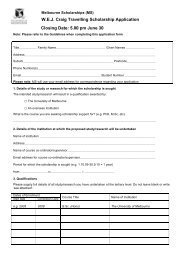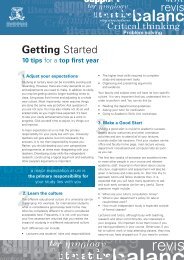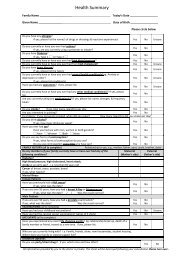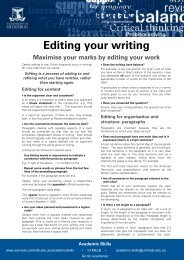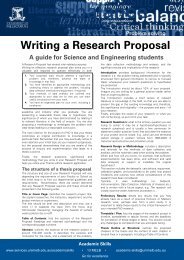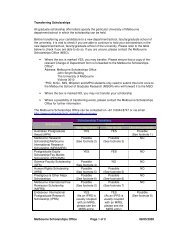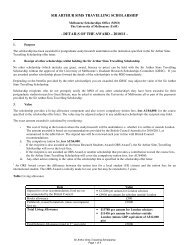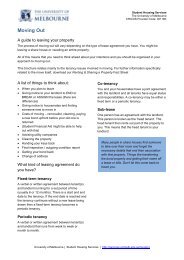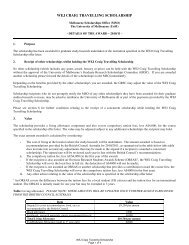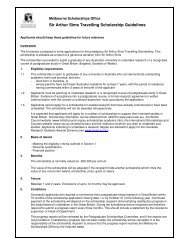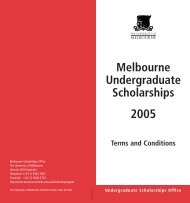a growing experience - Student Services - University of Melbourne
a growing experience - Student Services - University of Melbourne
a growing experience - Student Services - University of Melbourne
Create successful ePaper yourself
Turn your PDF publications into a flip-book with our unique Google optimized e-Paper software.
HEALTH AND WELL-BEING OF INTERNATIONAL STUDENTSGuidelines for the rating <strong>of</strong> severity <strong>of</strong> scores, based on the normative sample, havebeen established for the DASS scales. Using these guidelines, it is possible to classifystudent scale scores on a continuum from normal to extremely severe. The results arepresented in Table 39. Just as the means <strong>of</strong> the three scales are slightly higher thanthe means <strong>of</strong> the normative sample, so too the distributions <strong>of</strong> scale scores in thepresent sample are skewed compared with the distributions <strong>of</strong> the normative sample.However, there is need for great caution in interpreting these data. The scales werenormed on an Australian sample drawn from a range <strong>of</strong> white and blue collaroccupations, including some university students, with an age range <strong>of</strong> 17 – 69 years.In particular, cultural differences will have affected present results in an unknownway. The most useful approach is to look at the relative distributions <strong>of</strong> scores on thethree scales for the international student sample. From this it can be seen that anxietypresents a greater challenge to this group than either depression or stress.Table 39Classification <strong>of</strong> students’ scale scores according to degree <strong>of</strong> severityNormalMildModerateSevereExtremely severeDepressionscale (n=963)NumberPercentageAnxiety scale(n=961)NumberPercentageStress scale(n=959)NumberPercentage(Normativesample: 78%)59461.754857.065668.4(Normativesample: 9%)13213.710310.710811.3(Normativesample: 8%)14515.016917.610911.3(Normativesample: 3%)515.3555.8626.5(Normativesample: 2%)414.3868.9242.5Factors differentiating among students in terms <strong>of</strong> their levels <strong>of</strong> depression seem t<strong>of</strong>ocus on maturity, connectedness and cultural stress, and progress with studies.• There is a significant negative correlation with age, indicating in general theyounger the student the higher the level <strong>of</strong> depression 201 .• Single students have a significantly higher score on the Depression scale thanstudents with partners 202 .• Undergraduate students have a significantly higher Depression scale score thanpostgraduate students (whether coursework or research) 203 .• <strong>Student</strong>s who feel their academic progress is below expectation have significantlyhigher levels <strong>of</strong> depression than other students doing as well as or better thanexpected 204 .• <strong>Student</strong>s who undertook a Foundation Studies program have a significantly higherDepression scale score than those who did not 205 .201 =-0.15, p


